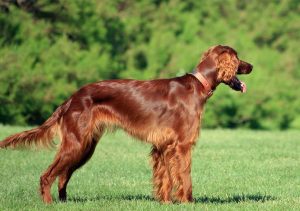Irish Setter
Breed description
With its regal stance, graceful gait and intelligent gaze, the Irish Setter is the perfect gentleman’s companion. Despite its fine-boned appearance and show-ring success, this glossy gundog is an apt shooting companion. The breed stems from Ireland, from red and white Spaniel types that were used for hunting, around the 17th Century. They later gave way to an apparently superior, deep-red shade of setter dog, that later became the Irish Setter breed as we know it today.
Traditional red and white dogs were no longer accepted, until the Irish Red and White Setter breed was later established. The Irish or Red Setter is a wonderfully friendly, outgoing dog that can make as wonderful a family pet as it does a working dog.
Pros
- Gorgeous dogs with the temperament to match
- Athletic and nimble, can sustain high levels of activity
- Trainable and obedient
Cons
- Fairly large sized dog – inappropriate for apartment living
- Some fur maintenance is required
- Regular daily exercise is a must
Suitable for
It’s no surprise that the Irish Setter makes a great gundog, even to this day. However, it is also frequently seen enjoying other activities such as agility and flyball. Its intelligence, trainability and friendliness can also make it a great service or assistance dog, whilst many are quite content just being part of the family.
- Working dog
- Active families or couples who enjoy an outdoor lifestyle
As long as its exercise needs are met, the Irish Setter can make a wonderful addition to any family.
Breed care advice
The most important aspects of Red Setter care to bear in mind are coat care and exercise. Maintaining that glossy, red, picture-perfect coat means daily brushing to keep it sleek and knot free, paying particular attention to a good groom after any romps in the countryside or undergrowth. That said, we wouldn’t say this is a chore, taking time for some regular grooming not only keeps your Irish Setter comfortable and elegant-looking, but it’s also the perfect time for some owner-pet bonding. If your Irish Setter is particularly prone to getting dirty, then a monthly bath should be enough to keep him glossy and easy to brush, whilst a targeted wash can be used after walks to remove any minor dirt.
Activity is important when considering getting an Irish Setter, these are traditionally working dogs with high athletic ability and endurance. They need a good amount of exercise each day, so it’s important to be certain that you are able to commit to this before taking the breed on. A minimum or one hour’s walk or outdoor activity is advisable, in order to keep these intelligent and active dogs happy and well.
Known health problems
As with most breeds, there are a number of health-related problems associated with the Irish Setter. This doesn’t mean that an individual will definitely suffer any or all of such problems, just that there’s a higher-than-normal prevalence of certain conditions across the breed as a whole. Care should be exercised when considering a puppy, to assess the existence of any inheritable conditions in the parent dogs.
Firstly, being a large, deep chested breed, the Red Setter is at risk of Gastric Dilatation and Volvulus, known as GDV. Here, the stomach distends with gas and twists on itself. The result can be life-threatening: the blood supply to the stomach is compromised, as is the volume of blood returning to the heart, leading to shock and potentially necrosis (tissue death) of the stomach. It occurs very quickly and requires immediate treatment, in order to save the dog and give it the best possible chance of a successful recovery. It’s important to know the signs so you can get your dog help straight away, so if you see him retching without bringing anything up, crying or appearing in pain for no reason or you notice a distended tummy, get your Setter checked out by the vet as an emergency.
Hip dysplasia isn’t uncommon amongst Irish Setters. There is a genetic tendency within certain affected lines for this condition. It involves abnormal formation of the hip joints leading to joint incongruence, pain, lameness and, over time, arthritic changes. The British Veterinary Association/Kennel Club (BVA/KC) hip score should be used to assess breeding dogs, in order to avoid breeding from affected individuals. It’s a chronic condition that can often be managed in the early stages with exercise modification and perhaps joint supplementation, but later may require anti-inflammatory therapy or even joint surgery, to keep the dog comfortable. However, strong selective breeding and hip scoring in recent years has reduced the prevalence of the condition, and it now tends to be associated with certain bloodlines.
- GDV
- Hip dysplasia
- Progressive retinal atrophy – an inherited condition that leads to abnormal structure of the retina (the back of the eye where important structures involved in the vision pathways are located). Eventually there is progressive loss of vision
- Combined leukocyte adhesion disorder (CLAD) – this is an inherited disorder in some Red Setters. It can lead to blood clotting problems and susceptibility to infection.
- Irish Setters may be at higher risk of hypothyroidism (underactive thyroid), resulting in lethargy, weight gain, coat and heart problems.
Article by Yvette Bell MRCVS

